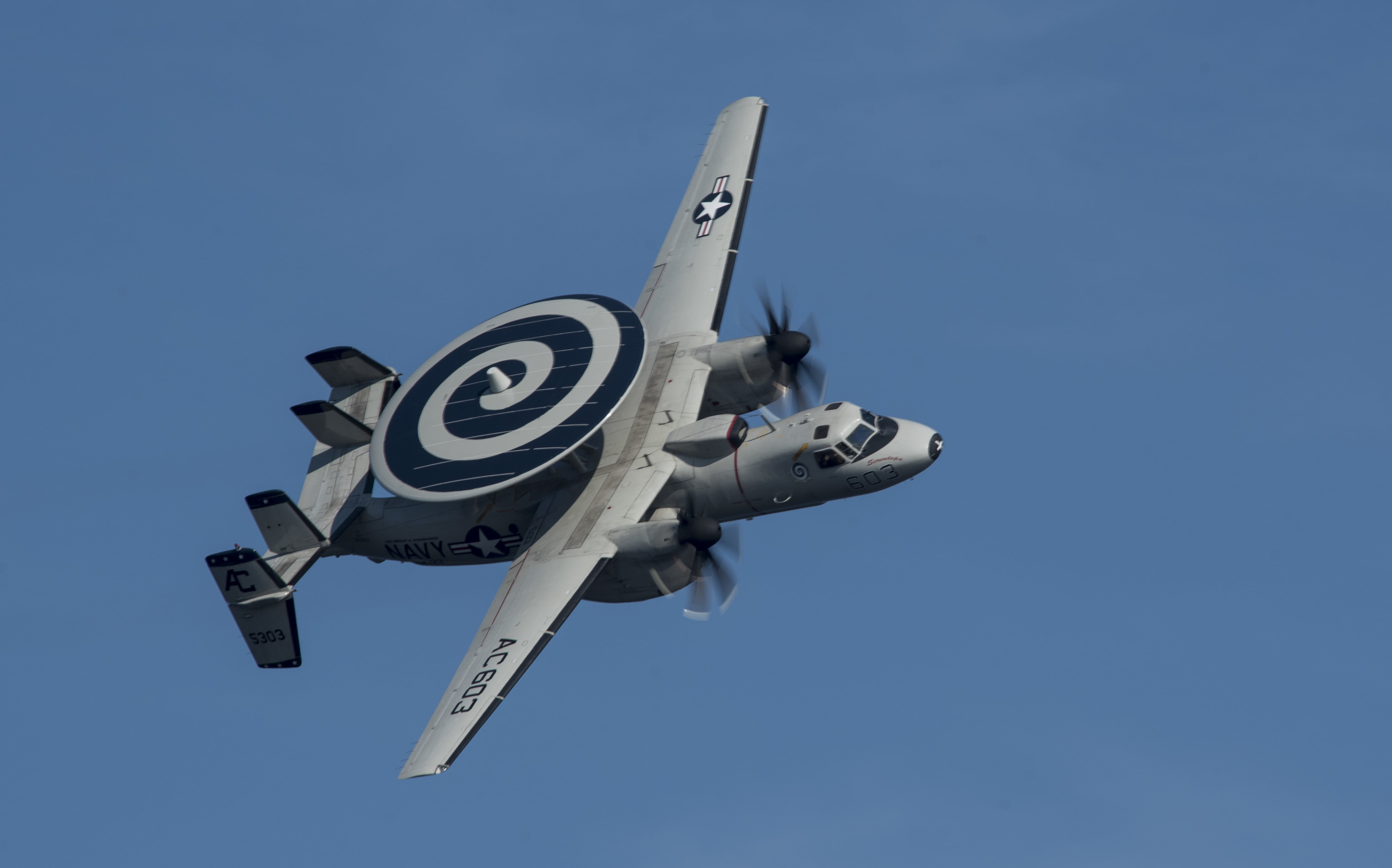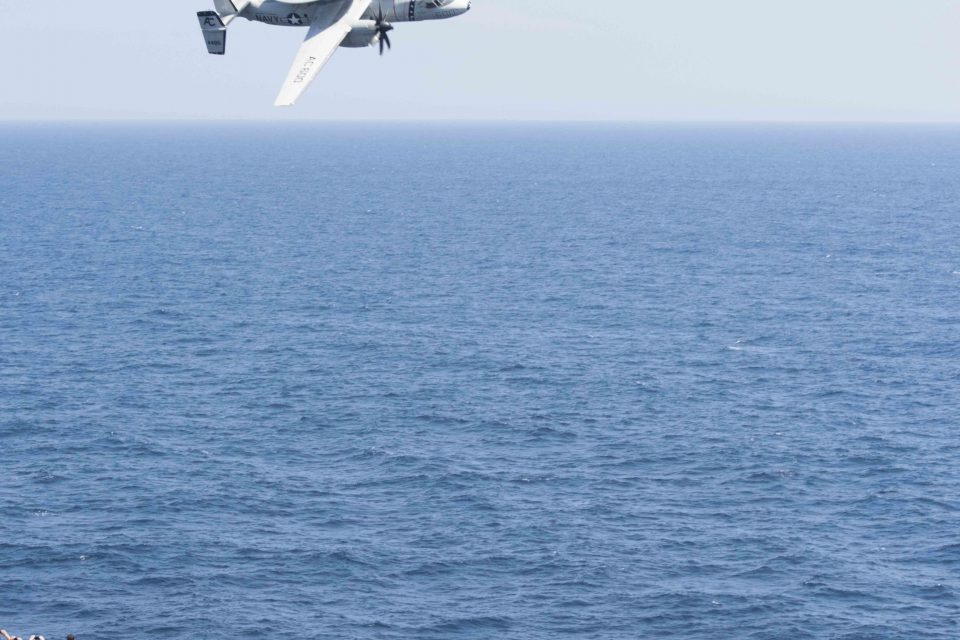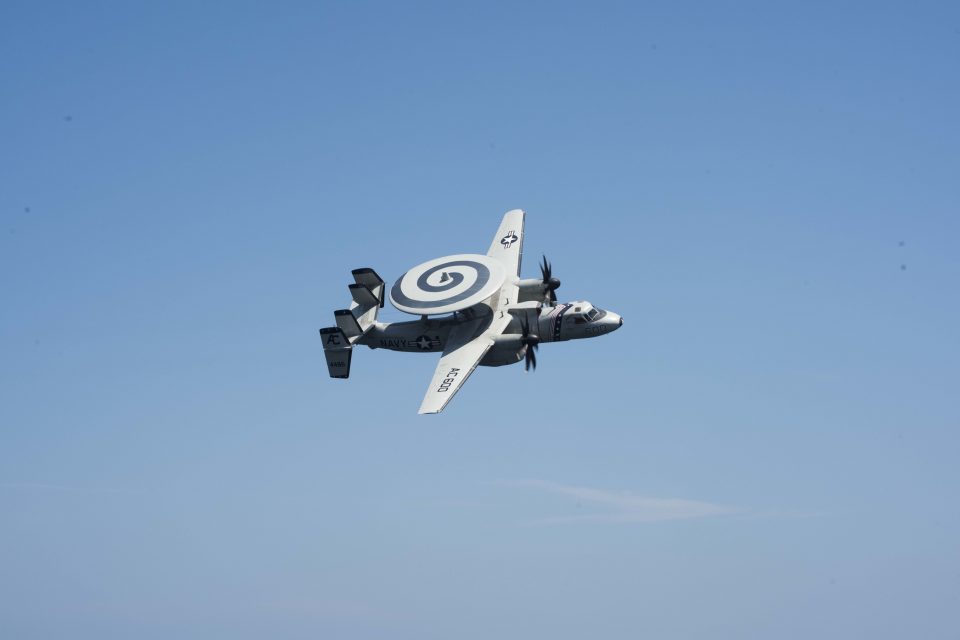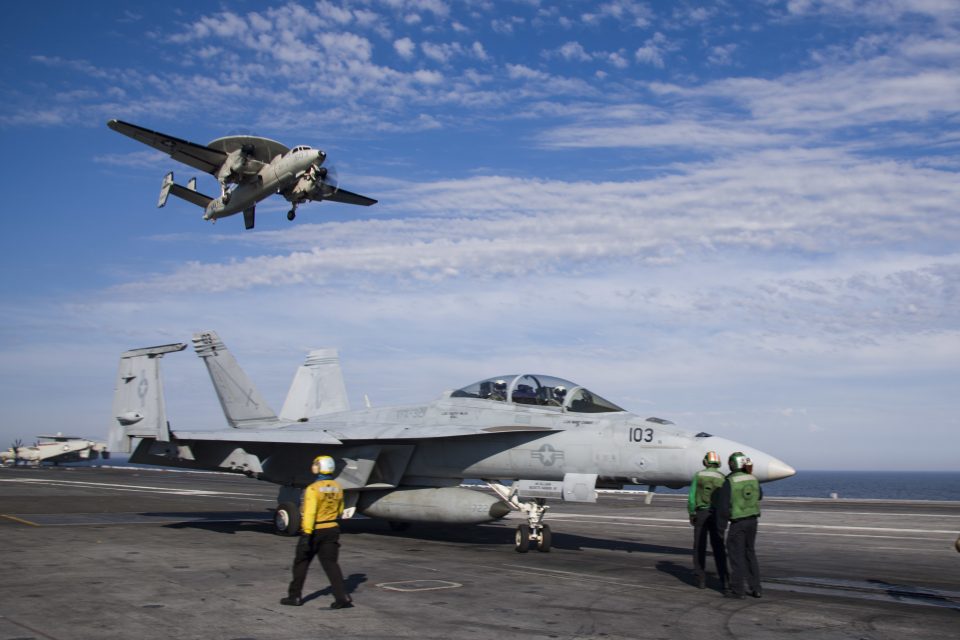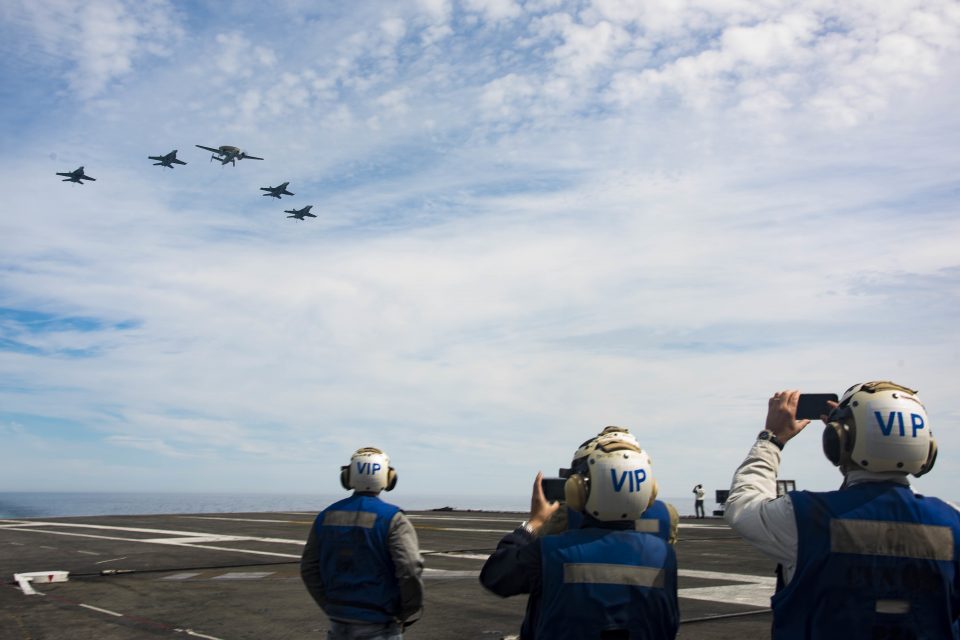2017-08-11 By Robbin Laird and Ed Timperlake
The new variant of the Hawkeye has come to the fleet.
The E-2D IOC’d with VAW-125 in 2014.
And aboard the USS Theodore Roosevel, they completed a CENTCOM deployment ISO OIR.
Then earlier this year, the E2-DE-2D as it is known arrived in Japan with a flourish to join into the defense of Japan and of the US fleet in Pacific operations.
According to a press release from the Commander of Naval Forces Japan and dated February 2, 2017:
IWAKUNI, Japan (NNS) — Carrier Airborne Early Warning Squadron (VAW) 125 arrived at Marine Corps Air Station (MCAS) Iwakuni, Feb. 2.
The “Tigertails” of VAW-125 are relieving the “Liberty Bells” of VAW-115 as the early-warning squadron of the U.S. Navy’s Carrier Air Wing (CVW) 5, supporting the Ronald Reagan (CVN 76) Carrier Strike Group.
“We are excited to join the forward-deployed naval forces at Marine Corps Air Station Iwakuni in the amazing city of Iwakuni,” said Cmdr. Daniel Prochazka, VAW-125’s commanding officer. “I would like to thank the city for its hospitality and for warmly welcoming us to this incredible place. This is my second time in the forward-deployed naval forces. My fond memories make me personally very thrilled to be back.”
VAW-125’s arrival also brings enhanced capabilities to the region, as the squadron’s five E2-D Advanced Hawkeye aircraft provide substantial upgrades over the E-2C Hawkeye platform. VAW-125 is the U.S. Navy’s first operational fleet squadron to utilize the E-2D.
The Advanced Hawkeye Extends The Reach of the Fleet from SldInfo.com on Vimeo.
“VAW-125 is the first and most experienced E-2D squadron in the U.S. Navy,” Prochazka said. “This aircraft has the most advanced airborne radar in the world, and the people who fix and fly it are the best in the U.S. Navy.”
Among the improvements in the E-2D are an all-new electronics suite, enhanced turboprop engines, modernized communications, and upgrade potential for mid-air refueling capabilities.
The U.S. Navy first took delivery of the E-2D July 2010, and began a phased replacement of the venerable E-2C aircraft which has served the fleet since 1973.
Prochazka added the forward deployment of VAW-125 to MCAS Iwakuni is in accordance with the U.S. Navy’s strategic vision for rebalance to the Indo-Asia-Pacific region, putting the most advanced and capable units forward in order to support the United States’ commitment to the defense of Japan and the security and stability of the region.
“I am proud to bring the E2-D Advanced Hawkeye to Japan and to help strengthen the alliance between our two great nations,” he said. “I am confident that our people and equipment will continue to build upon the vital relationship between our two countries.”
http://www.navy.mil/submit/display.asp?story_id=98672
But this is just the beginning.
Although identified as a replacement for the “venerable E-2C aircraft” it is more than that.
It is a key element off reshaping how the Navy is working the digital battlespace and evolving its integration with other key assets will expand the reach and capability of the fleet to deal with evolving threats.
To do so will require pushing the training envelope as the new systems are integrated into a developing and evolving digital battlespace.
As a software upgradeable aircraft, the systems will interact with and evolve with other new assets such as the P-8 and Triton (external to the Carrier Air Wing) and with the F-35C (which will be organic to the CAG.)
We had a chance to discuss the way ahead for the training for the Advanced Hawkeye and its evolving roles as well for the fleet with three members of NAWDC’s N6 department, better known as the Carrier Airborne Early Warning Weapons School (CAEWWS).
According to the Navy:
The Carrier Airborne Early Warning Weapons School (CAEWWS) is the E-2 weapon school and responsible for Airborne Tactical Command and Control advanced individual training via the Hawkeye Weapons and Tactics Instructors (HEWTIs) class.
CAEWWS is also responsible for development of community Tactics, Technique and Procedures and provides inputs to the acquisition process in the form of requirements and priorities for research and development (R&D), procurement, and training systems.
CAEWWS works closely to support other warfare development centers and Weapons Schools; such as the Surface and Mine Warfare Development Center’s Integrated Air Defense Course (IADC) and Integrated Air and Missile Defense WTI Integration Course (IWIC).
Other functions include support to advanced integrated fleet training by way of WTI augmentation to the N5/STRIKE Department for CVW integrated training detachments; also known as Air Wing Fallon Detachment and support of squadron activities.
https://www.cnic.navy.mil/regions/cnrsw/installations/nas_fallon/about/nawdc.html
The interview also highlighted the evolving working relationship between the surface fleet with NAWDC which is a key feature of setting in motion ways to enhance combat integration within the training and development effort, given the central role which TPPs play in shaping combat capabilities to fight with the fleet you have and the one in the process of change.
The head of CAEWWS is Commander David Dees. Joining him in the interview were LT Cremean, the Maritime Employment subject matter expert and CAEWWS Training Officer and LT Andrew Blanco, who is one of the surface warfare liaison officers and an Integrated Air and Missile Defense WTI.
The mix of personnel reflects how the Navy is working to enhance current capabilities and to put in place the kind of cross-platform multi-dimension warfare domain thinking, which is essential for the evolving fleet.
We started by discussing the work flow of the five man crew onboard the Advanced Hawkeye which is different from Hawkeye in that the co-pilot has greater involvement in the execution of the mission data engagement flow.
“By adding a fourth crew member with the ability to utilize the full tactical system we expanded the ability to execute the mission by moving certain tasks to the cockpit.
“It brings new challenges in tactical crew coordination as the crew is no longer able to reach out and interact with that person next to them in the back of the aircraft.”
Inside the E-2, the pilots are not the mission commanders, for that role resides in the back of the aircraft with the Naval Flight Officers or NFOs.
“The co-pilot may also be dealing with the challenges of flying the aircraft and any aircraft issue that may come up, so he can experience task overload.
“This is why we are carefully developing the tactical contracts the co-pilot has, but with the full work station he does now fully participate in the tactical mission which gives us more capability to manage the crew workload.”
Currently, the Hawkeye is used to support the strike effort off of the carrier.
But as the battlespace is changing so will the Hawkeye role.
A key change is the ability to detect threats in a cluttered battlespace.
Here the training needs to focus on the challenge of target identification in a fluid battlespace.
The advanced Hawkeye has sensors appropriate to the task, but enhanced training efforts with regard to this key task is envisaged.
“Target identification is the hard part.”
The Hawkeye team is a key part of the acquisition engagement payload utility function for the fleet.
And associated with the evolving challenge of target acquisition is shaping an effective decision making cycle as well to deal with threats.
Hawkeye is clearly part of the decision making cycle but the overall evolution of executing this capability against evolving threats is a work in progress.
For example, the Advanced Hawkeye has capabilities which are part of air and cruise missile defense and working through the entire package of dealing with this threat is at the heart of the evolving training regime.
And the new emphasis on distributed lethality means that the role of forward operating assets such as advanced Hawkeye are seeing a reworking of the role of the crews onboard an asset like Hawkeye in the decision making loop.
We clearly saw this happening as well in the P-8-Triton community so that one can note that there is a broader shift of emphasis on mission command within the fleet to sort out how different assets will play which roles in the evolving battlespace.
Admiral Harris noted that the Admiral Swift, Commander of the Pacific Fleet, and his team were working hard on the rethink on decision-making authorities.
According to Admiral “Hyfi” Harris: “What authorities should reside where and when?
“They are driving towards mission command which is crucial to deal with evolving threats.”
The E-2D is a software upgradeable aircraft and is a key player in shaping the ISR/C2 capabilities operating from the carrier.
The F-35 coming to the carrier deck also has key radar capabilities, notably built by the same company, Northrop Grumman, and working integration will provide a key opportunity to enhance the capabilities of the CAG in supporting fleet operations.
Clearly, tools like Live Virtual Constructive training will become increasingly more important in training for the extended battlespace and there is a clear need to work integration with live assets today with US and Allied forces in order to lay down a solid foundation for something like LVC.
The team emphasized the need to have the advanced assets at NAWDC to allow for the kind of integrated training, which is clearly necessary.
They would like to see E-2Ds and F-35Cs physically at NAWDC to allow for the kind of hands on experience, which can build, integrated cross platform training essential for the development of the skill sets for dominance in the 21st century battlespace.
One could also add, that the need to build ground floor relationships between code writers and operators needs to include the TTP writers as well.
Hence, a different pattern is emerging whereby training is as much about combat development TTPs as it is about single platform proficiency.
“The problem is right now, we don’t have aircraft here to fully develop cross platform integration, because we don’t have enough time spent together to figure out the optimal direction to drive that kind of integration.”
With regard to a future Hawkeye, the team saw a clear benefit to making the next Hawkeye a jet.
It was not simply a question of range and speed, but ease of maintenance.
“The current plane is a great plane. If the follow-on platform was a jet aircraft tanking will be a lot easier. It will make maintenance a lot easier as well.”
Editor’s Note: It is often a media template to bring sunlight on US Defense corporations with a shading that somehow very decent people wake up every morning and try and figure out how to make mistakes.
But there is a corresponding upside to American engineering genius, which is the worldwide proliferation of American systems often in different platforms.
The very practical application of similar systems in U.S. and Allied fighting forces is very simple.
The famous concept of “Tec-Reps” technical representatives supported by industry is invaluable for advancing the state-of-the art in perfecting ever better technological performance.
The same in TTP development is also so true especially with the E-2D, F-35, USN Triton and RAAF Wedgetail combat systems all having a developmental commonality.
Northrop Grumman builds and supports the radars on a number of key platforms flown by the US Navy and the allies with whom the USN operates as well.
There is a commonality across the platforms as Northrop builds scalable digital radars and the new approach to radar technology lays a foundation for the kind of interactive integration crucial for cross domain high intensity warfare which is becoming a clear focus at NAWDC.
The video and slideshow photos are credited to the US navy.


